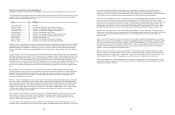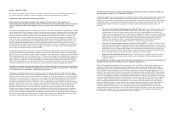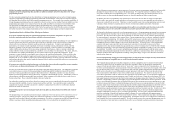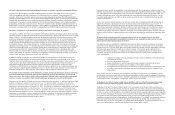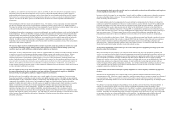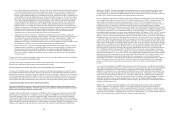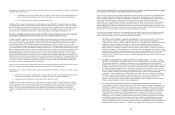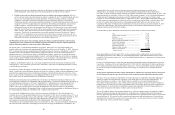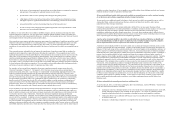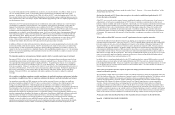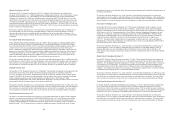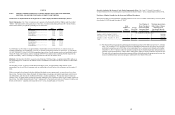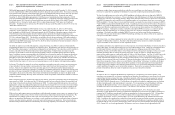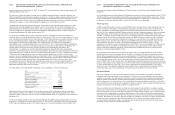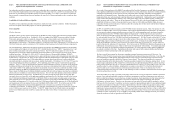Dish Network 2012 Annual Report Download - page 26
Download and view the complete annual report
Please find page 26 of the 2012 Dish Network annual report below. You can navigate through the pages in the report by either clicking on the pages listed below, or by using the keyword search tool below to find specific information within the annual report.
40
40
In addition, we may incur substantial additional debt in the future. The terms of the indentures relating to our senior
notes permit us to incur additional debt. If new debt is added to our current debt levels, the risks we now face could
intensify.
It may be difficult for a third party to acquire us, even if doing so may be beneficial to our shareholders,
because of our ownership structure.
Certain provisions of our certificate of incorporation and bylaws may discourage, delay or prevent a change in
control of our company that a shareholder may consider favorable. These provisions include the following:
x a capital structure with multiple classes of common stock: a Class A that entitles the holders to one vote
per share, a Class B that entitles the holders to ten votes per share, a Class C that entitles the holders to one
vote per share, except upon a change in control of our company in which case the holders of Class C are
entitled to ten votes per share;
x a provision that authorizes the issuance of “blank check” preferred stock, which could be issued by our
Board of Directors to increase the number of outstanding shares and thwart a takeover attempt;
x a provision limiting who may call special meetings of shareholders; and
x a provision establishing advance notice requirements for nominations of candidates for election to our
Board of Directors or for proposing matters that can be acted upon by shareholders at shareholder meetings.
In addition, pursuant to our certificate of incorporation we have a significant amount of authorized and unissued
stock which would allow our Board of Directors to issue shares to persons friendly to current management, thereby
protecting the continuity of its management, or which could be used to dilute the stock ownership of persons
seeking to obtain control of us.
We are controlled by one principal stockholder who is also our Chairman.
Charles W. Ergen, our Chairman, owns approximately 51.0% of our total equity securities (assuming conversion of
all Class B Common Stock into Class A Common Stock) and beneficially owns approximately 52.1% of our total
equity securities (assuming conversion of only the Class B Common Stock held by Mr. Ergen into Class A
Common Stock). Under either a beneficial or equity calculation method, Mr. Ergen controls approximately 88.0%
of the total voting power. Mr. Ergen’s beneficial ownership of shares of Class A Common Stock excludes
9,886,441 shares of Class A Common Stock issuable upon conversion of shares of Class B Common Stock
currently held by certain trusts established by Mr. Ergen for the benefit of his family. These trusts own
approximately 2.2% of our total equity securities (assuming conversion of all Class B Common Stock into Class A
Common Stock) and beneficially own approximately 4.4% of our total equity securities (assuming conversion of
only the Class B Common Stock held by such trusts into Class A Common Stock). Under either a beneficial or
equity calculation method, these trusts possess approximately 3.8% of the total voting power. Through his voting
power, Mr. Ergen has the ability to elect a majority of our directors and to control all other matters requiring the
approval of our stockholders. As a result, DISH Network is a “controlled company” as defined in the Nasdaq
listing rules and is, therefore, not subject to Nasdaq requirements that would otherwise require us to have: (i) a
majority of independent directors; (ii) a nominating committee composed solely of independent directors; (iii)
compensation of our executive officers determined by a majority of the independent directors or a compensation
committee composed solely of independent directors; and (iv) director nominees selected, or recommended for the
Board’s selection, either by a majority of the independent directors or a nominating committee composed solely of
independent directors. Mr. Ergen is also the principal stockholder and Chairman of EchoStar.
Legal and Regulatory Risks Affecting our Business
Our business depends on certain intellectual property rights and on not infringing the intellectual property rights
of others.
We rely on our patents, copyrights, trademarks and trade secrets, as well as licenses and other agreements with our
vendors and other parties, to use our technologies, conduct our operations and sell our products and services. Legal
challenges to our intellectual property rights and claims of intellectual property infringement by third parties could
41
41
require that we enter into royalty or licensing agreements on unfavorable terms, incur substantial monetary liability
or be enjoined preliminarily or permanently from further use of the intellectual property in question or from the
continuation of our businesses as currently conducted, which could require us to change our business practices or
limit our ability to compete effectively or could have an adverse effect on our results of operations. Even if we
believe any such challenges or claims are without merit, they can be time-consuming and costly to defend and divert
management’s attention and resources away from our business. During the second quarter 2012, the four major
broadcast television networks filed lawsuits against us alleging, among other things, that the PrimeTime Anytime
and AutoHop features of the Hopper set-top box infringe their copyrights. In the event a court ultimately determines
that we infringe the asserted copyrights, we may be subject to, among other things, an injunction that could require
us to materially modify or cease to offer these features. Moreover, because of the rapid pace of technological
change, we rely on technologies developed or licensed by third parties, and if we are unable to obtain or continue to
obtain licenses from these third parties on reasonable terms, our business, financial position and results of operations
could be adversely affected.
We are party to various lawsuits which, if adversely decided, could have a significant adverse impact on our
business, particularly lawsuits regarding intellectual property.
We are subject to various legal proceedings and claims which arise in the ordinary course of business, including
among other things, disputes with programmers regarding fees. Many entities, including some of our competitors,
have or may in the future obtain patents and other intellectual property rights that cover or affect products or
services related to those that we offer. In general, if a court determines that one or more of our products or services
infringes on intellectual property held by others, we may be required to cease developing or marketing those
products or services, to obtain licenses from the holders of the intellectual property at a material cost, or to redesign
those products or services in such a way as to avoid infringing the intellectual property. If those intellectual
property rights are held by a competitor, we may be unable to obtain the intellectual property at any price, which
could adversely affect our competitive position. Please see further discussion under “Item 1. Business — Patents
and Other Intellectual Property” of this Annual Report on Form 10-K.
We may not be aware of all intellectual property rights that our services or the products used in connection with our
services may potentially infringe. In addition, patent applications in the United States are confidential until the
Patent and Trademark Office either publishes the application or issues a patent (whichever arises first). Therefore, it
is difficult to evaluate the extent to which our services or the products used in connection with our services may
infringe claims contained in pending patent applications. Further, it is often not possible to determine definitively
whether a claim of infringement is valid.
Our ability to distribute video content via the Internet involves regulatory risk.
As a result of recent updates to certain of our programming agreements which allow us to, among other things,
deliver certain authenticated content via the Internet, we are increasingly distributing video content to our
subscribers via the Internet. The ability to continue this strategy may depend in part on the FCC’s success in
implementing rules prohibiting discrimination against our distribution of content over networks owned by
broadband and wireless Internet providers. For more information, see “Item 1. Business — Government
Regulations — FCC Regulations Governing our DBS Operations — Net Neutrality” of this Annual Report on Form
10-K.
Changes in the Cable Act, and/or the FCC’s rules that implement the Cable Act, may limit our ability to access
programming from cable-affiliated programmers at non-discriminatory rates.
We purchase a large percentage of our programming from cable-affiliated programmers. Pursuant to the Cable Act,
cable providers had been prohibited from entering into exclusive contracts with cable-affiliated programmers. The
Cable Act directed that this prohibition expire after a certain period of time unless the FCC determined that the
prohibition continued to be necessary. On October 5, 2012, the FCC allowed this prohibition to expire. While the
FCC has issued a Further Notice of Proposed Rulemaking aimed at serving some of the same objectives as the
prohibition, there can be no assurances that such protections will be adopted or be as effective as the prohibition if
they are adopted. In the event this decision is reconsidered by the FCC or reviewed by a court of appeals, we cannot
predict the timing or outcome of any subsequent FCC decision.


